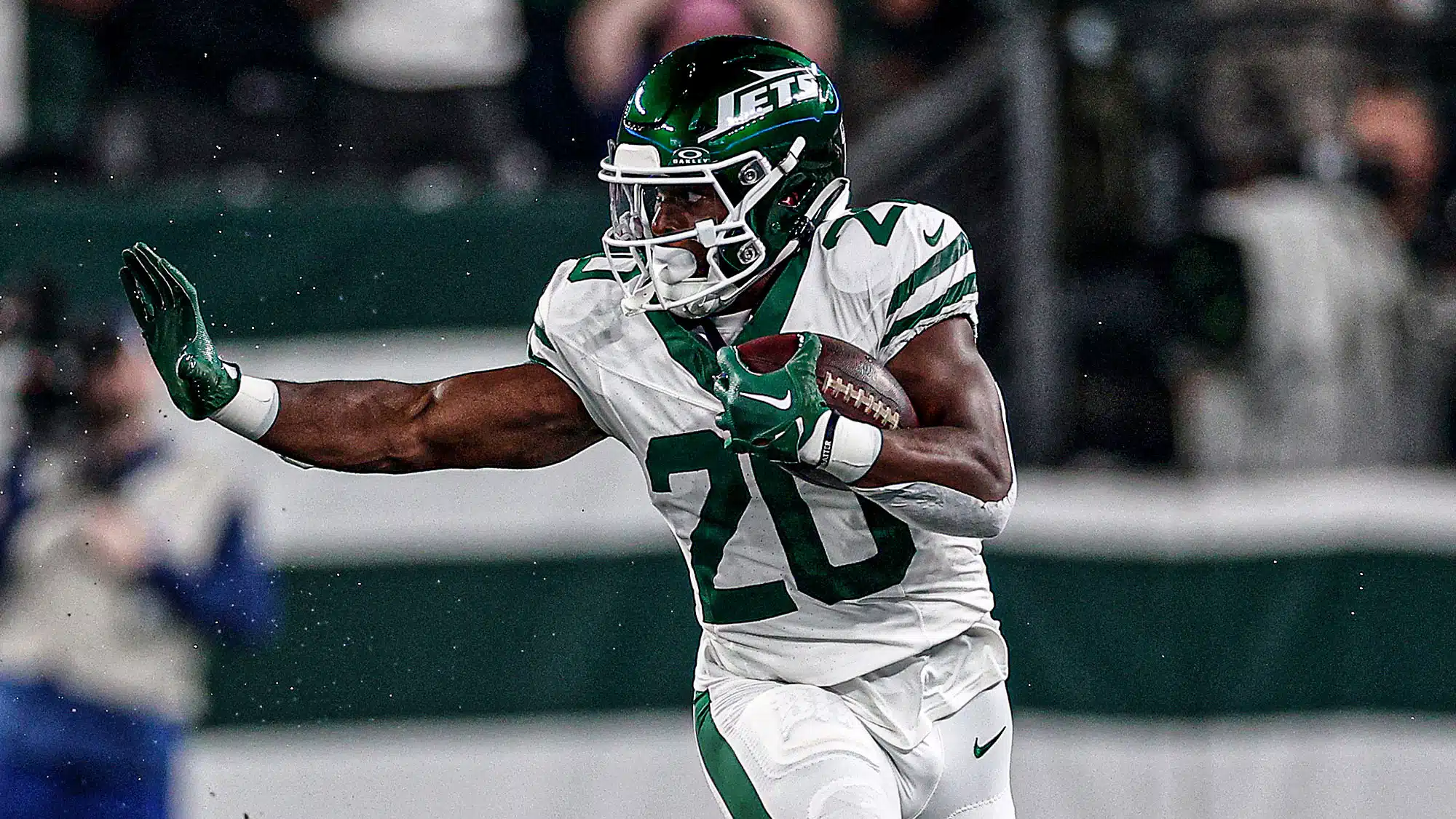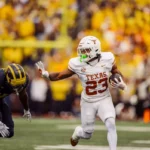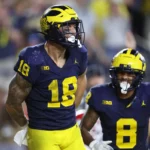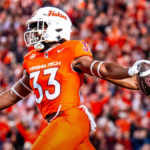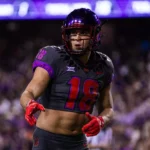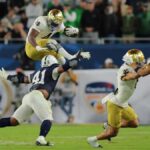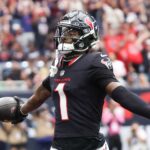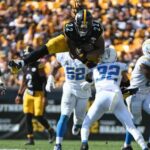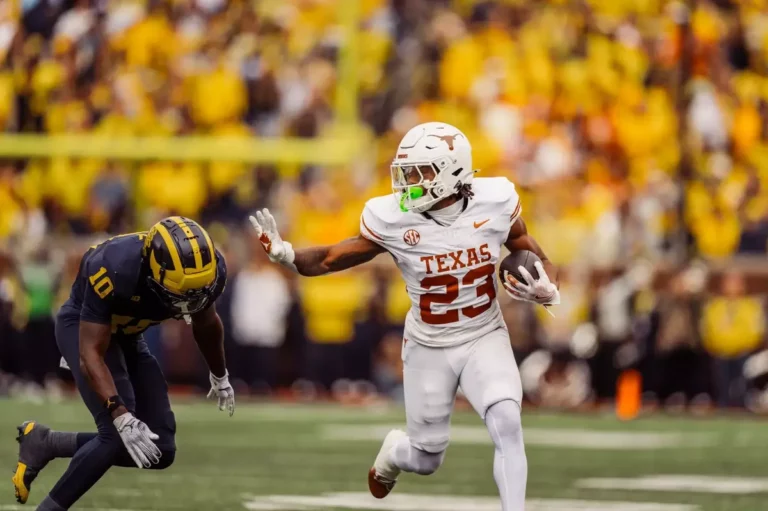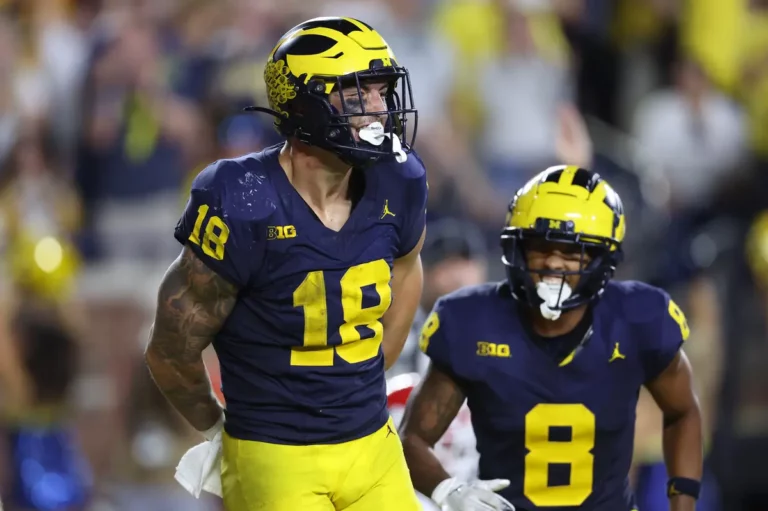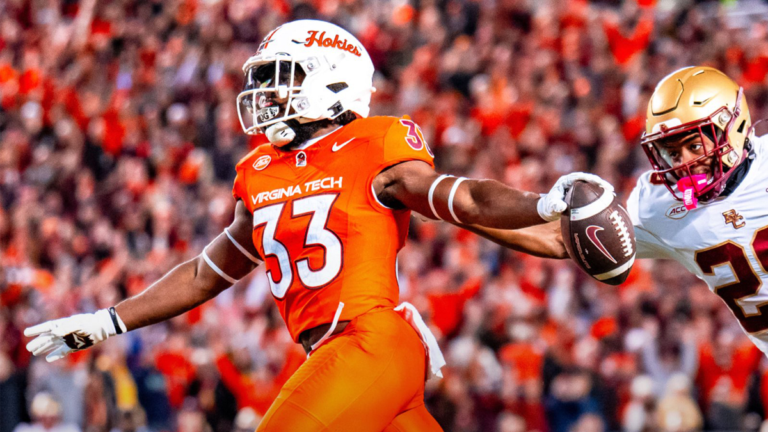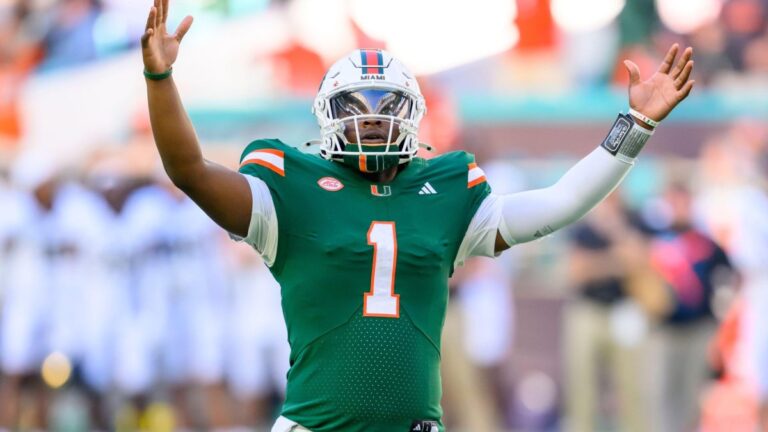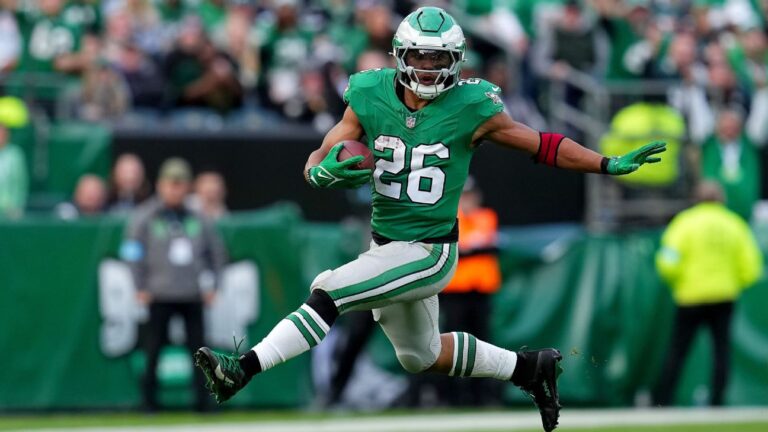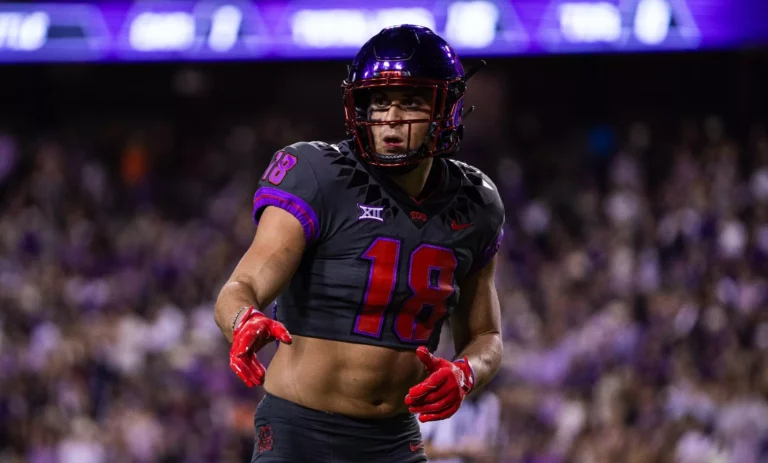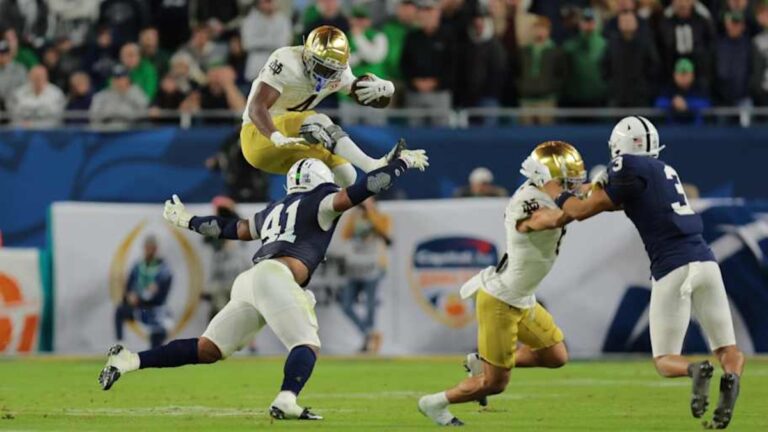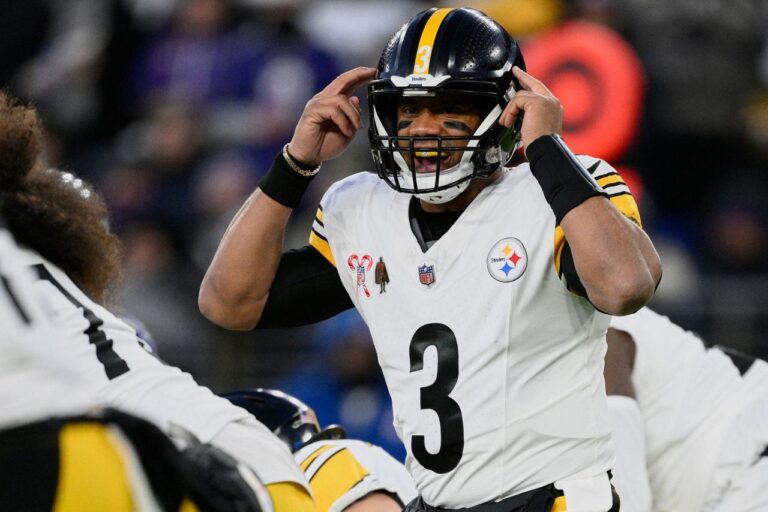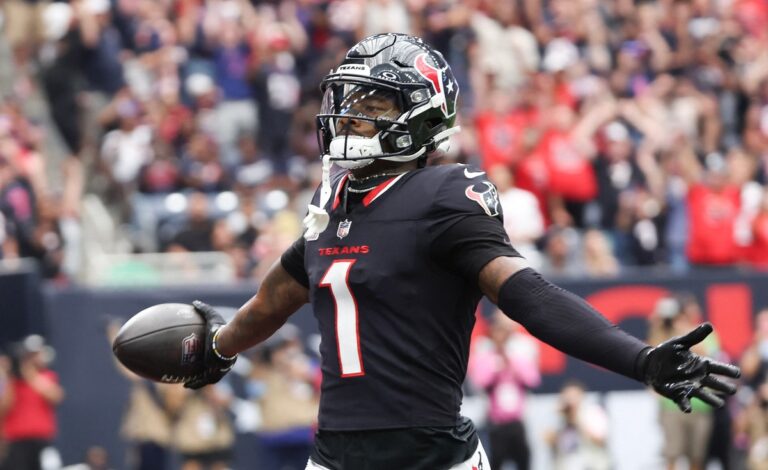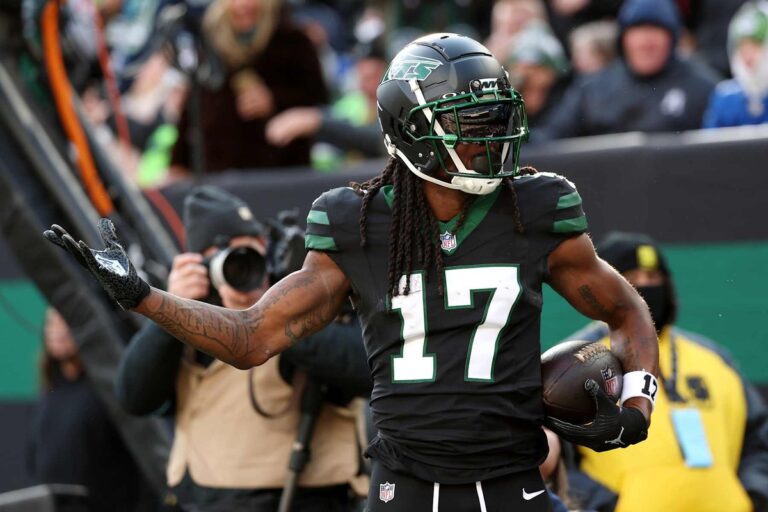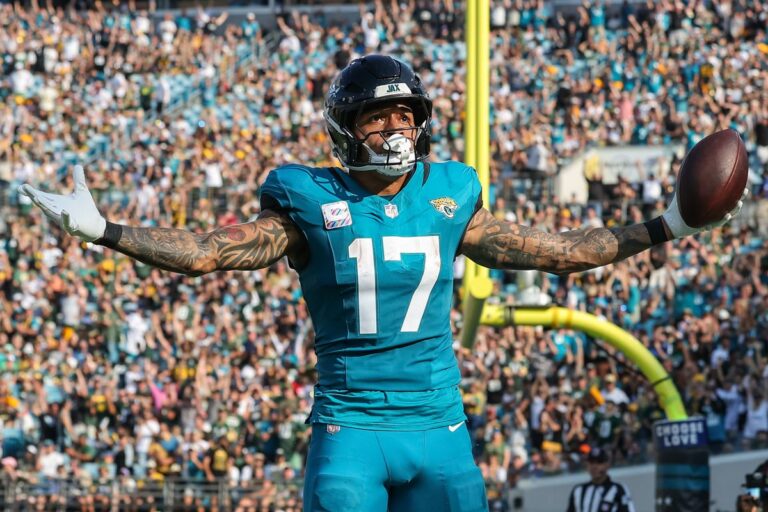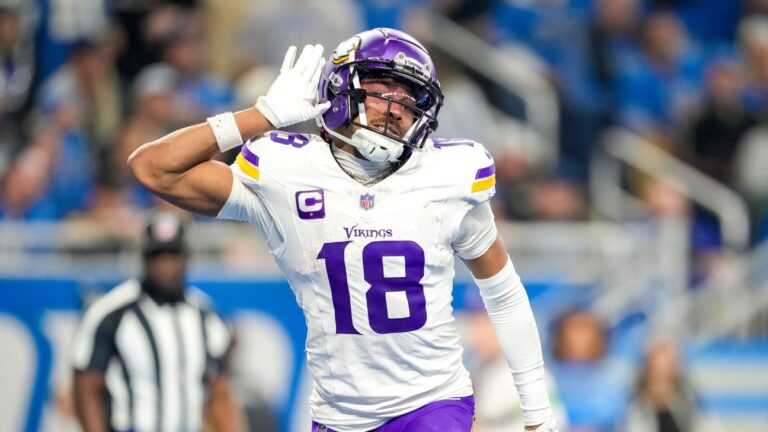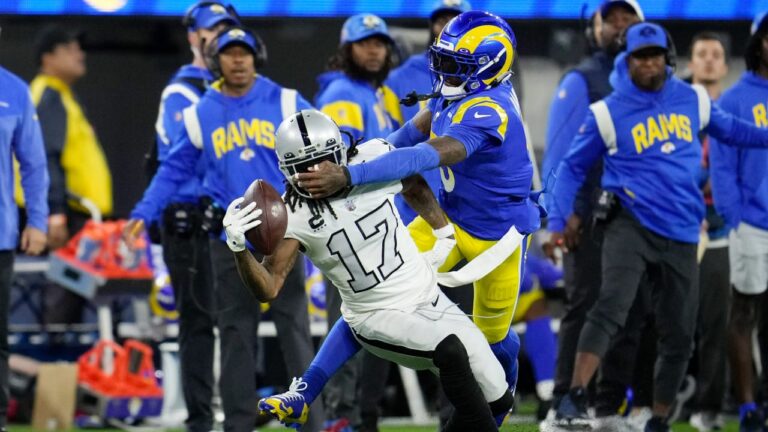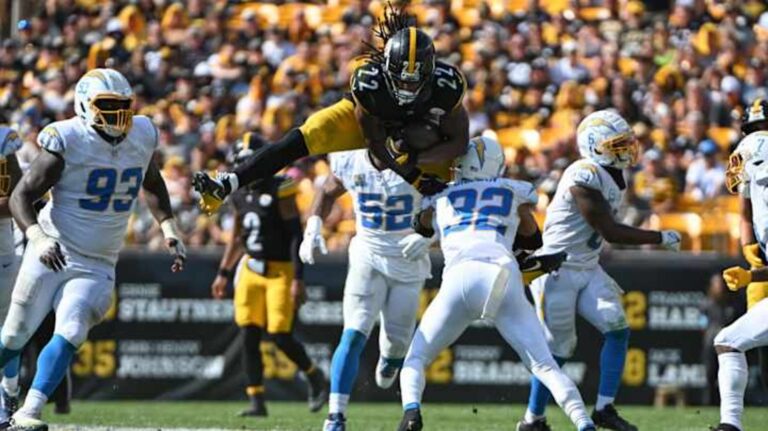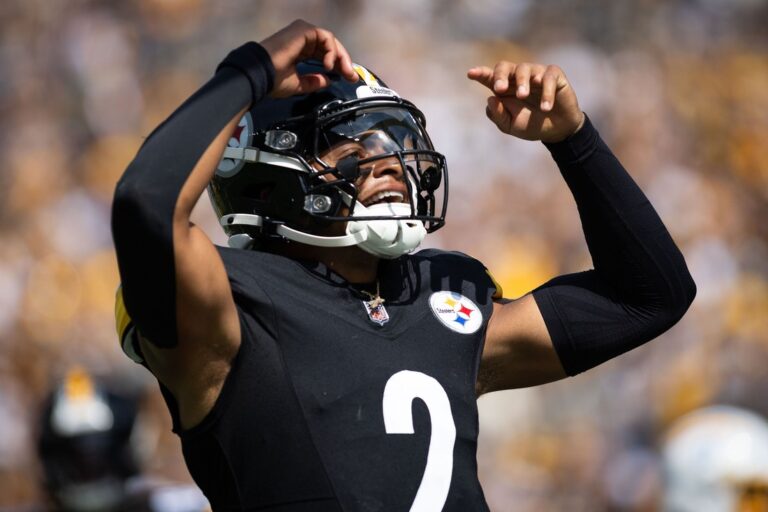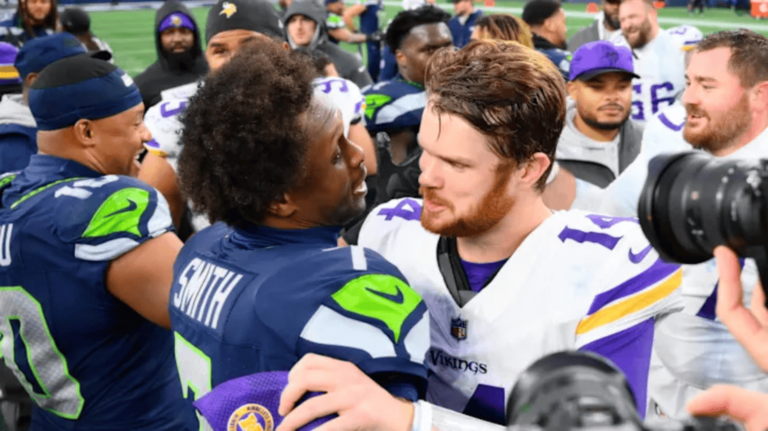Now that the fantasy football auction player prices are set, it’s time to develop the perfect 2024 fantasy football auction strategy (pre-draft) and game plan.
Please click here if you haven’t read part 1 of this series. Part 1 includes an overview of my fantasy football auction draft philosophy, plus an amazing Excel tool to help you set the perfect player prices.
Part 1: How to Dominate a Fantasy Football Auction Draft – Setting Player Prices
Part 2: How To Dominate a Fantasy Football Auction Draft – Developing a Game Plan
Part 3: How To Dominate a Fantasy Football Auction Draft – In-Draft Strategy & Tips
Now that you’ve set the perfect 2024 fantasy football auction player prices — customized with your league settings/history and value-based drafting — it’s time to formulate a league-winning auction game plan. Below, we use our pricing tool to form a blueprint, analyzing how to attack and budget for each position.
OVERALL AUCTION VIEW & TRENDS
After inputting my league rules and site-specific numbers, I first like to look at the Auction sheet for a few minutes. Scroll through the list and see if any of the values are particularly different from what you were expecting. You will probably find a few that pop out.
All the following screenshots (zoom in) and analysis are based on a 12-team, full-PPR league with 1QB, 2RB, 3WR, 1TE, 2FLX.
Your league might be different, so this series aims to teach you how to analyze any league format and draw sound conclusions. Read part 1 to learn how to customize the tool to your league settings.
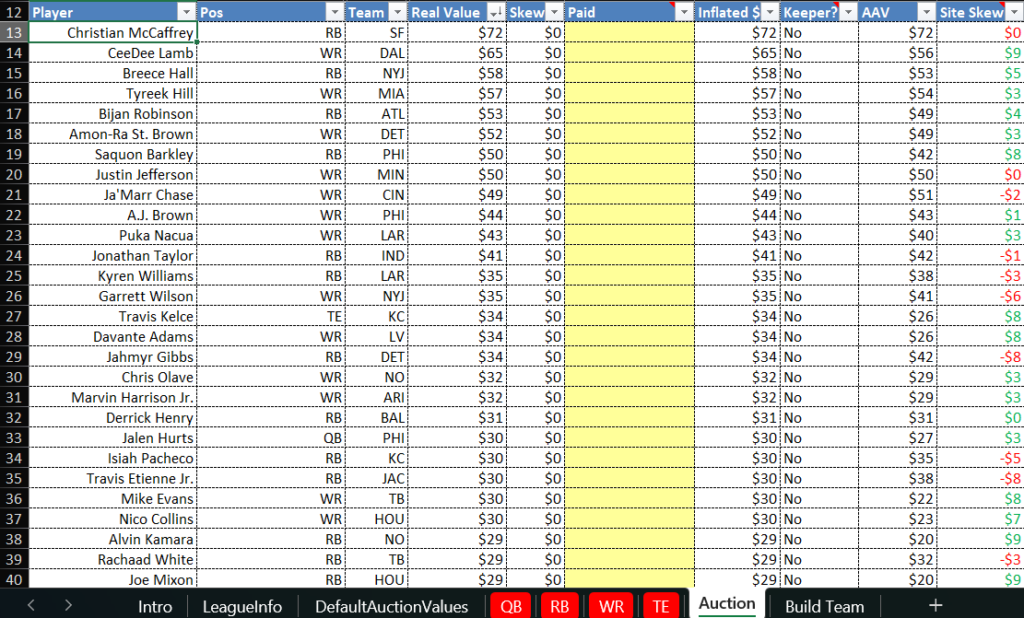
Three things jump out at me:
- Finding league-winning players is much easier in the first round of your draft, so grabbing 1 or 2 of the top-ranked “sure things” in the top five makes a ton of sense.
- The QB position is generally overvalued based on these league settings at nearly every price point. I would be okay chasing a top option or settling for a mid-tier option with upside for the right price, but given this data, I would be okay drafting a couple of very cheap options.
- The TE position is generally undervalued, with solid options available at nearly every price point. I want a top-10 option. I don’t want to punt the position and miss out on value.
After scanning the data overall, I filter the Auction sheet by position (see: POS column, second in from left, and filter) to spot any position-specific trends.
QB POSITION BREAKDOWN
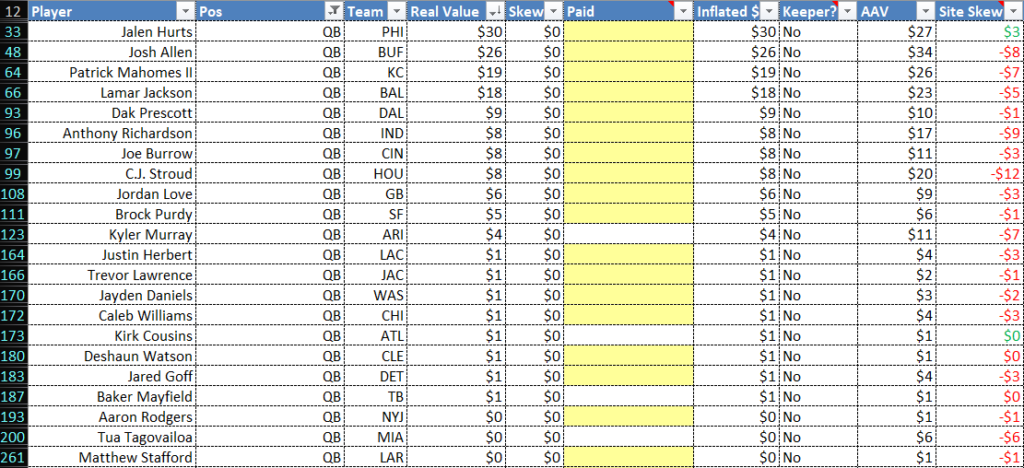
As a general rule, I like to budget the QB position last. This particular league format requires starting seven total running backs and wide receivers each week, which slightly diminishes QB value compared to a league with fewer starting positions. In addition, I found some great value at RB and WR, so I didn’t have much money left over for QB in this particular build.
If these were the true QB prices, I would prefer to draft cheap options. Because DeAndre Hopkins and Calvin Ridley are two of the best values in this format, I like taking a shot on Will Levis for $1. I also like Jayden Daniels as a cheap dart throw. Vets like Jared Goff and Matthew Stafford are safer deep options.
I have no problem targeting Josh Allen, Patrick Mahomes, Jalen Hurts, or Lamar Jackson in your auction draft if you can fit them into your budget, but they have a real opportunity cost. Each is going for at least $23 on average, and Allen is much higher at $34. They didn’t fit on this particular build, but you can play around with the tool and try to build teams with an elite QB.
Two-QB leagues are, of course, different – adjust the settings in the tool to see their prices skyrocket.
RB POSITION BREAKDOWN
Summary: Budget a huge portion for RBs. Pay up for McCaffrey, Breece, or Bijan. Try to secure at least one guy with high-end RB1 potential.
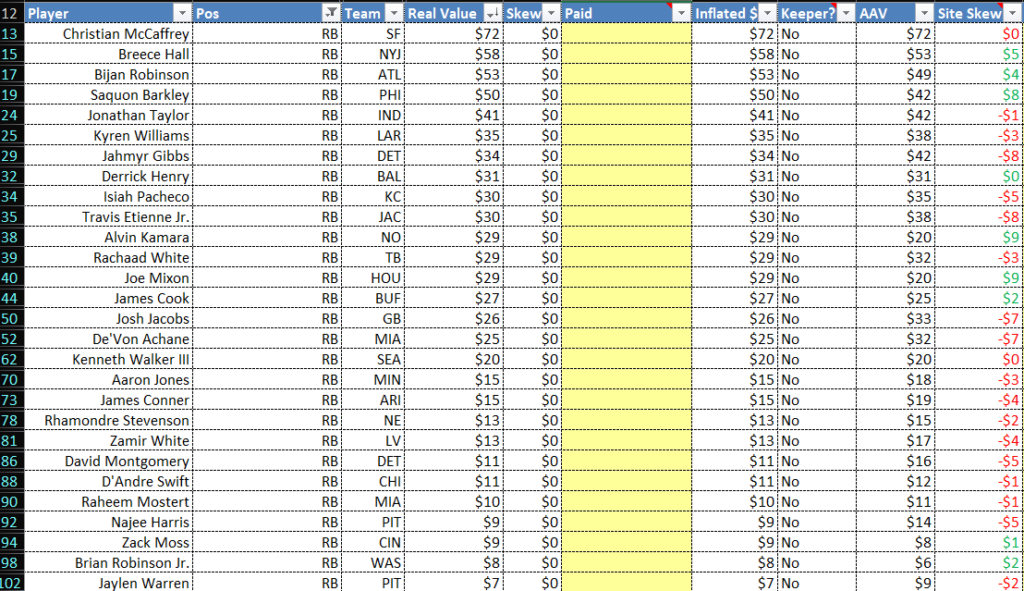
At first glance, many running backs are being overvalued by AAV, with a lot of negative sites skewing towards the top. It may seem like the optimal RB strategy would be to punt the position and stick with cheap options, but our goal is to draft players with league-winning upside.
Even if all players were valued perfectly by the site I was playing on, I still would try to target at least one top back because my preferred strategy at running back is bell cow or bust. I want players with the best chance of dominating their team’s rushing and receiving share.
Here are the percentage odds (by round) the player you drafted returned a WAR of 2.0 or higher: pic.twitter.com/ckNt8lBFZU
— Scott Barrett (@ScottBarrettDFB) July 20, 2022
Your only real chance to draft a league-winning running back is in the first two rounds, so I want at least one guy in this range. If the price is right, I would even consider drafting two of Christian McCaffrey, Breece Hall, and Bijan Robinson since they are the clear top options at the position, but that won’t be realistic in most drafts.
If you miss out on the top guys, Saquon Barkley, Derrick Henry, and Jonathan Taylor are potential alternatives with significant upside. Alvin Kamara and Joe Mixon are nice values if you’re looking to save money.
High-end backs are expensive, but I am willing to spend on them because I know I can find cheaper players at other positions to fill out my roster. If you play in a larger league, two elite backs might be too expensive, so I encourage you to download the tool and check out custom values based on your league settings.
WR POSITION BREAKDOWN
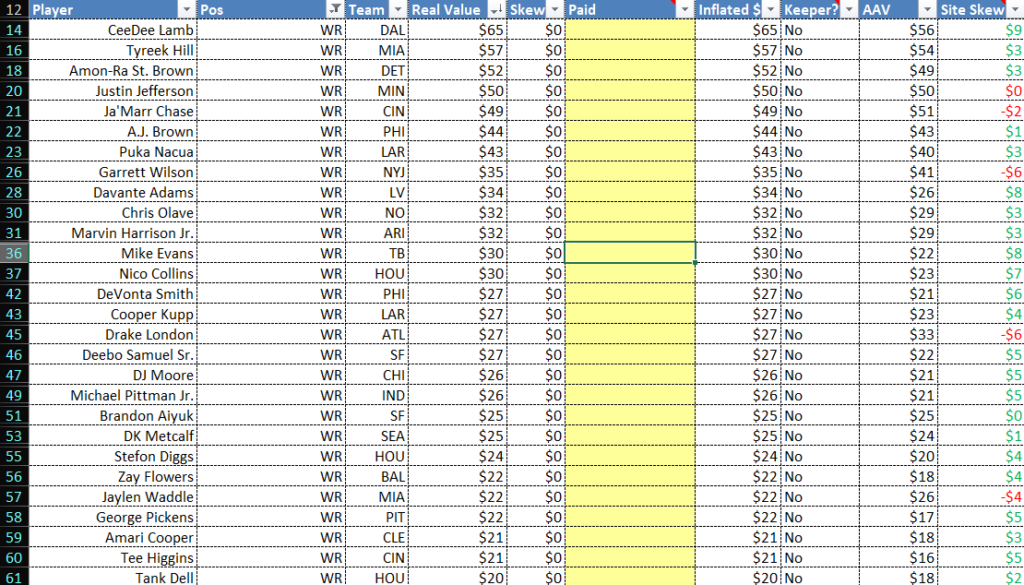
Summary: If you can afford one top WR, go for it. But generally, after paying up for RBs, target the mid-tier WRs to round out your starting lineup. Then, load up on high-upside, low-cost “Penny Stocks” like Curtis Samuel or underappreciated young guys like Dontayvion Wicks at the end of the draft.
Because the wide receiver position is deeper than running back, drafting a receiver to start in your flex spot is typically the best strategy in full-PPR leagues.
Pairing a high-level RB like Hall or McCaffrey with 1-2 high-upside receivers, and then loading up on your favorite receivers in the WR20-WR30 range seems like a solid strategy here.
Since a ton of solid veteran receivers like Davante Adams, Cooper Kupp, Calvin Ridley, Mike Evans, and DeAndre Hopkins also have favorable site skews, building a team around these players is even more enticing. However, if you love one of the top receivers and prefer to only spend on one top back, adding a top receiver like CeeDee Lamb could make sense here.
TE POSITION BREAKDOWN
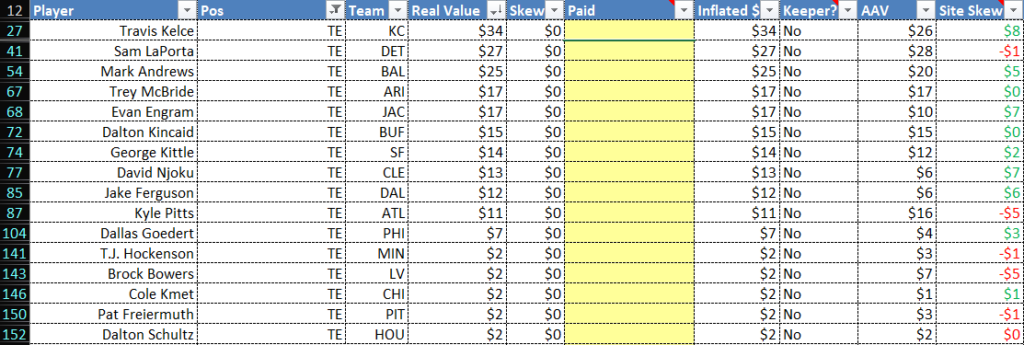
Most tight ends have positive site skews, meaning the position is collectively undervalued. You can build a team around almost any option, but the goal is to draft high-upside players. All of the top 10 TEs in the tool have a realistic chance to finish among the top 2 or 3 at the position in 2024, and I would generally be fine with any of them at their AAV.
Typically, a key criterion for tight ends to have upside is to be a top-2 target earner on their NFL team. George Kittle has been the fourth option in the 49ers passing attack with everyone healthy, but he made up for it by running routes on nearly every dropback last year. David Njoku could potentially slip behind new teammate Jerry Jeudy in the target pecking order, so I would rank him last of the top 10.
Mark Andrews fits well onto the team I’ve built at only a $20 AAV, which feels like an excellent price for a guy who has been the overall TE1 in the past. If you miss out on Andrews, Kyle Pitts is again another intriguing upside option with Kirk Cousins at the helm and a new offensive scheme.
You can technically stream tight end, but doing so is very difficult because the player pool is shallow. If you get desperate for a cheap option, Pat Freiermuth looks poised to be a top-2 target earner on the Steelers, although I would prefer one of the top guys.
AUCTION MOCK DRAFT SUMMARY
After breaking down the data by position, my initial plan would be to draft cheap QBs, a high-end running back paired with a cheaper option, a mix of potentially elite receivers with some mid-tier guys to fill out the lineup, and Andrews at tight end. A sample starting lineup I like would be something like this:
QB: Will Levis $1
RB: Breece Hall $53
RB: Joe Mixon $20
WR: Davante Adams $26
WR: Cooper Kupp $23
WR: Mike Evans $22
Flex: Calvin Ridley $9
Flex: DeAndre Hopkins $6
TE: Mark Andrews $20
Total: $180
Note that this sample team is for a 12-team PPR league. Your league might be different, but you can still use the same process to generate a realistic sample team for your league.
If you dislike the players I selected, that’s okay! You can swap them for comparable alternatives and end up with a team you like better. Similarly, I can plug in alternatives if a few players go for more than expected.
This team should leave me with around $20 to draft bench players I like, as well as some breathing room to spend a bit more than I expect on a few players. I usually plan to spend about $180 on my starting lineup, so this fits perfectly.
I probably won’t finish my draft with this exact roster, but I can build a similar team in most drafts. To complement your first sample team, I would suggest having a list of similarly-priced alternative players you like for each starting spot to build your margin of safety. In addition, if you experiment and map out 5 or 10 different builds, you will likely have something that resembles your real draft, no matter how it shakes out.
Stay alert for part 3, the final part of the series, where I reveal my best in-draft tips.
DOWNLOAD THE ULTIMATE AUCTION PRICE TOOL
Our Auction Series is all you need to dominate your 2024 Fantasy Football Auction Drafts. Don’t miss a single part:
- Part 1: Customizing Player Prices
- Part 2: Initial Game Plan and Budget by Position
- Part 3: In-game domination
